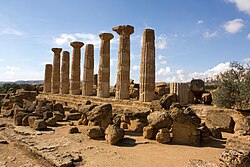Temple of Heracles, Agrigento
| Temple of Heracles, Agrigento | |
|---|---|
 Columns of the Temple of Heracles | |
 | |
| General information | |
| Location | Agrigento, Sicily |
| Coordinates | 37°17′25″N 13°35′11″E / 37.29028°N 13.58639°E |
The Temple of Heracles or Temple of Hercules (the Roman name of the
The building, in the
This temple is located approximately one kilometer to the west of Temple of Concordia.
History
The traditionally accepted chronology of the temple identifies it as the most ancient of the Greek Akragantine temples, dating to the final years of the 6th century BC.[3] This dating is based on stylistic characteristics, especially its proportions, number of columns, and the profile of the columns and of their capitals. However, some connect the temple with the activities of Theron (Tyrant of Akragas 488-473/2 BC), claiming that it contains innovations compared to the architectural practice of the 6th century.[4] In that case, it could be identified with the temple of Athena recorded by Polyaenus (Stratagems 6.51) in relation to the building activities of Theron after his seizure of power.
The remains of the entablature constitute a problem for dating, because there are two types of cymatium with gutters and lion heads: the first, less well-preserved than the other, datable to the 460s BC and the second datable to around the middle of the fifth century. Probably the first cymatium is the original and was replaced by the second a few decades later (for reasons unknown). The temple's foundation is considered to be dated to the years before the Battle of Himera (480 BC); its completion would have taken a decade or maybe a little more.
The building was restored in the Roman period with some modifications. The naos was divided into three, which could indicate a dedication to multiple divinities. If still in use by the 4th and 5th centuries, it would have been closed during the persecution of pagans in the late Roman Empire.
In the 20th century, restorers have reconstructed nine of the columns on the southeastern side through anastylosis. In addition, they restored part of the entablature and some of the capitals.
Architecture

The building was constructed on a
In the building's remains, internal stairs for the inspection of the roof can be seen in the walls between the pronaos and the naos. Such stairs became a typical feature of Akragantine temples. The tall columns are topped by wide capitals, with a deep gulf between the stem and the
See also
References
- ^ "Tempio di Eracle". Archived from the original on 10 October 2011. Retrieved 12 August 2011.
- ISBN 8882650480, p.86
- ^ Ernesto De Miro, La Valle dei Templi di Agrigento, 1986, p.8
- ISBN 8870627993, pp.70-71


